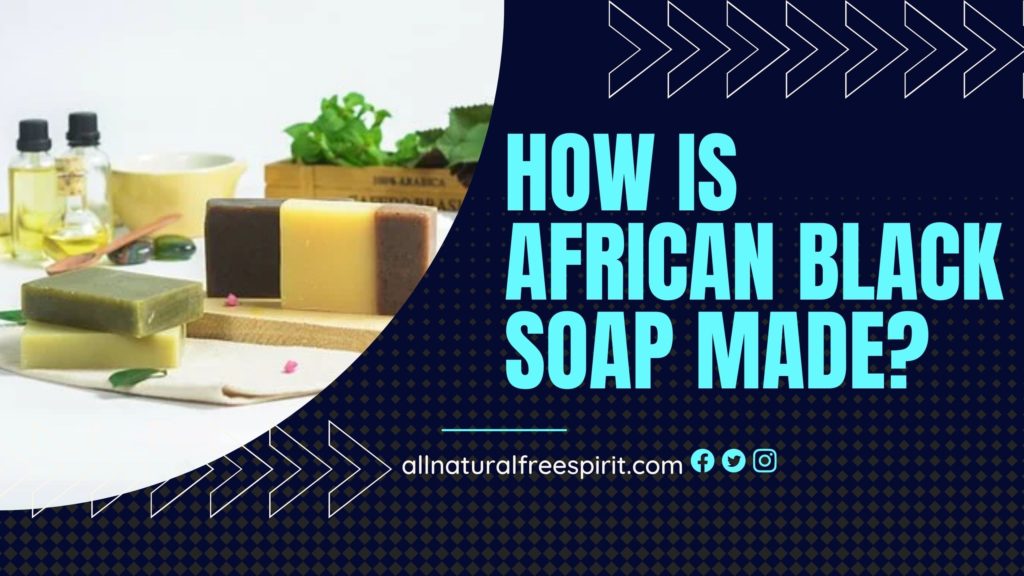Africa black soap is having a blast right now! You can find it in stores like Walmart, Target, and even online retailers such as Amazon. This soap is made from a combination of plantain skins, cocoa butter, and palm kernel oil. So, how is African black soap made?
Just like Egyptian magic soap or Dr. Bronner’s magic soap, African black soap is one of the most alluring and mysterious soaps on the market.
It’s also one of the oldest, dating back to at least the 16th century. The history of black soap is a bit murky, but it’s thought to have originated in West Africa, specifically Nigeria, Ghana, and Senegal.
So how is it made? How is African black soap made? Continue reading to find out how this magical soap is crafted!
How is African Black Soap Made?

It’s no secret that African black soap is a popular choice for people with sensitive skin. But what many people don’t know is how this soap is made.
Most people assume that it’s just a mixture of cocoa butter and palm oil, but there is actually a bit more to it than that!
Before learning how to make African black soap, it’s important to understand what African black soap is in the first place?
African Black Soap: What Is It
African black soap is a handmade, organic soap that’s been used for centuries to treat acne, eczema, psoriasis, and other skin conditions.
The soap is made from a combination of plantain skins, cocoa butter, and palm kernel oil, and it’s said to be beneficial for all skin types.
Traditionally, African black soap was made by women in Africa who would gather the necessary ingredients, cook them over a fire, and then hand-stir the mixture until it turned into soap.
Nowadays, the process is a bit different. Most African black soap that’s sold commercially is made in large batches by manufacturers.
However, there are still some small-scale producers who make the soap the traditional way.
So how is it made? Let’s find out.
Read: Should I stop using African black soap?

How Is African Black Soap Made?
The process of making African black soap is actually quite simple, but it can be a little bit time-consuming. Here’s how it’s done:
To make traditional African black soap, you’ll need the following ingredients:
What you will need: Ingredients
- 2 cups of plantain skins, chopped
- 1 cup of cocoa butter
- 1 cup of palm kernel oil
- 1/2 cup of Water
- 1/2 cup of ashes
- A pot
- A wooden spoon
- A bowl
- A container to store the soap in
Instructions
Step 1: Chop The Plantation Skin Into Pieces
Start by chopping up the plantain skins into small pieces. You can do this by hand or with a food processor. If you’re using a food processor, make sure to pulse the skins so that they’re chopped into small pieces but not too small.
The main reason for doing this is to make sure that the plantain skins are evenly distributed in the soap. If they’re too small, they might not dissolve properly and could end up clogging your pores.
You can also use a grater to grate the plantain skins into small pieces. This is a good option if you don’t have a food processor.
Step 3: Melt the Cocoa Butter and Palm Kernel Oil
Next, you’ll need to melt the cocoa butter and palm kernel oil. You can do this by heating them in a pot over low heat. Stir the oils occasionally to make sure that they’re melting evenly.
It’s important to melt the oils slowly so that they don’t get too hot. If the oils get too hot, they could end up burning the other ingredients.
Read: African black soap reviews

Step 4: Add the Plantain skins and Water to the Pot
Add the plantain skins and water to the pot once the oils are melted. Stir the ingredients together and cook them over low heat for about 30 minutes. Make sure to stir the mixture occasionally so that the plantain skins don’t stick to the bottom of the pot.
Boiling helps to release the oil and nutrients from the skins/flakes into the water and oil mixture. This is what gives your soap its nourishing and cleansing properties. After boiling, let the solution cool down for a few minutes. By now, you should have a Black thick goo.
Step 5: Add The Ashes To The Soap Mixture
Once the mixture has cooled, add the ashes and stir the ingredients together until they’re fully combined. Add slowly while stirring to give the solution a little thickness to avoid lumps. The ashes help exfoliate the skin and give the soap its signature black color.
Continue stirring until you get a smooth paste. The end result is a dense, creamy soap that’s perfect for cleansing your skin.
Step 5: Pour the Soap Into a Container
Once the soap mixture is smooth, pour it into a container and let it cool and harden completely. Let the soap cure for a few weeks before using it. This curing process allows the soap to develop its characteristic smell and texture.
You can use African black soap on your face, body, and hair. It’s a great all-in-one soap that can be used to cleanse and nourish your skin. Enjoy!
Read: How long does it take for black soap to clear skin?
Frequently asked Questions about Making African Black Soap
Can I Make African Black Soap At Home?
Yes, you can make African black soap at home. It’s a simple recipe that only requires a few ingredients.
What Are The Benefits Of African Black Soap?
African black soap is rich in vitamins and minerals that are great for the skin. It’s also known for its ability to cleanse and nourish the skin.
How Often Should I Use African Black Soap?
You can use African black soap as often as you like. It’s a gentle soap that can be used on your face, body, and hair.
So how is African black soap made? Well, this simple recipe only requires a few ingredients and some time to let the soap cure. Once it’s made, you can use it on your face, body, or hair. So go ahead and try this simple recipe at home!

